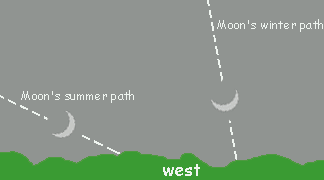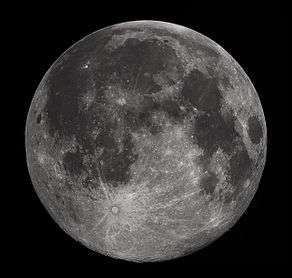Wet moon

A wet moon (also called a Cheshire moon) is a lunar phase when the "horns" of the crescent moon point up at an angle, away from the horizon, so the moon's crescent takes on the appearance of a bowl or a smile. A wet moon occurs when the crescent moon is near the horizon at a point more or less directly above the sun's (invisible) position below the horizon. This in turn is determined by the earth's and moon's positions in their orbits, the inclination of these orbits relative to one another and to the earth's axis, and observer's latitude on the earth. Wet moons occur routinely in the tropics (where the sun and moon rise and set nearly vertically), and rarely in polar regions (where the sun and moon rise and set at a glancing angle or not at all).
Name
The terms wet moon and dry moon originate from Hawaiian mythology, where it was thought that the moon appeared as a bowl which would fill up with rain. The period where this is most common, January 20 - February 18, corresponds with Kaelo the Water Bearer in Hawaiian astrology and makes the moon known as the "dripping wet moon". As the year passes into summer, the crescent shape shifts, pouring out the water and causing the summer rains. After the "bowl" empties, it dries out and rights itself, creating the "dry moon". However, others say that this is a wet moon because it permitted the water to pour out.
The term "Cheshire moon" is a reference to the smile of the Cheshire Cat of Lewis Carroll's story Alice's Adventures in Wonderland.
Explanation
The path which the sun takes among the stars is known as the ecliptic. The moon's orbit is inclined at five degrees to the ecliptic, so it will always be within five degrees either side of it. For half the sidereal month (relative to the stars) the moon is below the ecliptic and for half it is above. The point where the moon's orbit cuts that of the earth is the "node" – at the "ascending node" the moon moves from south to north and at the "descending node" it moves from north to south. These points are where eclipses occur – hence the name. The nodes move around the ecliptic at the rate of one circuit every 18.6 years. The ecliptic makes the steepest angle with the horizon at the equinoxes. The crescent moon is near the sun so it is at those times it will be seen lying on its back.
See also
External links
- StarChild Question of the Month for March 2002, NASA, accessed February 2006
- Ask the Astronomer: How often does a 'Dry Moon' happen with the horns of the Moon pointed straight up?, Astronomy Cafe, accessed February 2006
- "Wonderquest: Cheshire Moon, speedy sunset, languid eventide", USA Today, June 10, 2004
- http://www.kellscraft.com/ReadingWeather/readingweather09.html (Dry moon reference)
- Cheshire Moon, a set of songs by Bruce (2004)
